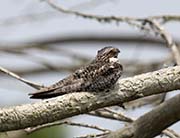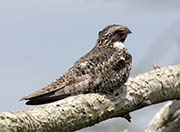Common Nighthawk - Chordeilles minor
| Length | |
| Wingspan | |
| Weight | |
| Clutch Size | |
| Chicks at birth | |
| IUCN Conservation Status | |
Continents: |
The Common Nighthawk is a medium sized bird with mottled brown, black and white feathers. They have large wings that are black with a white or buff colored bar.
Common Nighthawks are sexually dimorphic. The males have a white tail band and a white throat and thin buff eye rings. The female do not have the white tail band and their wing bars and throat are buff colored. Both sexes have large heads with large eyes, a tiny hooked bill which opens very wide, a notched tail and dark feet and legs.
Diet: Common Nighthawks eat moths, bugs, wasps, flies, mosquitoes, etc. Reportedly they can consume 500 mosquitoes in one day. They mostly feed from late afternoon to dusk. They have an especially large mouth which they use to catch insects while flying. They drink by flying over the surface of a pond or stream and skim with their lower mandible or by hovering over water.
Courtship: During breeding season, the male will dive straight down towards the ground. When he gets close to the ground he will quickly bend his wings downward. The air rushing through his wingtips will make a deep booming sound. This courtship behavior has earned it the name of the booming nighthawk.
Nesting: They do not construct nests, but lay the eggs on the ground on leaf litter, pine needles, etc. They will also nest on gravel roofs. Clutch size is usually 2 eggs. Their young are semi-precocial at hatching. They are feed by both parents who regurgitate crushed insects to the chicks.
Habitat and Range: Common Nighthawks breed throughout most of North America. They prefer open or semi-open country but can be found in urban areas. They winter in South America.
Plumage/Molt: The mottled brownish feathers of the Common Nighthawk provide good camouflage for
when they are on the ground. Their prebasic molt takes place on their wintering grounds in South America.
Migration: Common Nighthawks breed throughout most of North America and migrate to South America (as far south as Northern Argentina) for the winter.
Tongue/Feet: Small feet and weak legs which is why they sit rather than perch on tree limbs. They have a unique toothed claw on each foot called a "feather comb" that is thought to aid in grooming.
Bibliography:
- Cleere, Nigel, A Guide to the Nightjars, Nighthawks and their Relatives,Yale University Press, 1998
- Sibley, David Allen, The Sibley Guide to Bird Life & Behavior,Alfred A. Knopf, New York, 2001
- http://www.placeforwildbirds.org The Place for Wild Birds, Inc. Recovery Center, Accessed June 2012
- http://www.birds.cornell.edu The Cornell Lab of Ornithology, Accessed June 2012
- http://en.wikipedia.org The Free Encyclopedia, Accessed June 2012



